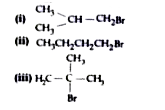Halogenation of an alkene is a /an-
substitution reaction
elimination reaction
addition reaction
oxidation reaction
The correct Answer is:C
Topper's Solved these Questions
- HYDROCARBONSBOOK - CHHAYA PUBLICATIONCHAPTER - HYDROCARBONSEXERCISE - EXERCISE (ADDITIONAL QUESTIONS)
125 Videos
- HALOAKANES AND HALOARENESBOOK - CHHAYA PUBLICATIONCHAPTER - HALOAKANES AND HALOARENESEXERCISE - Practise set 10 (Answer the following questions)
10 Videos
- HYDROGENBOOK - CHHAYA PUBLICATIONCHAPTER - HYDROGENEXERCISE - PRACTICE SET -9
5 Videos
Similar Questions
Knowledge Check
Halogenation of alkenes is
AA reductive processBAn oxidative processCAn isothermal processDAn endothermal processThe halogen which is most reactions , in the halogenation of alkanes under sunlight is .........
AChlorineBBromineCIodineDAll equalRead the passage given below and answer the following questions:
Alkyl/Aryl halides may be classified as mono, di or polyhalogen compounds depending on one, two or more halogen atoms in their structures. Alkyl halides are prepared by free radical halogenation of alkanes, addition of halogen acids to alkenes and replacement of -OH group of alcohols with halogens using phosphorus halides, thionyl chloride or halogen acids. Aryl halides are prepared by electrophilic substitution to arenes.
The following questions are multiple choice questions.
Choose the most appropriate answer:
Which of the following is halogen exchange reaction ?ARX+NaI→RI+NaXB CR−OH+HXZnCl2−−−→R−X+H2OD
CR−OH+HXZnCl2−−−→R−X+H2OD
Read the passage given below and answer the following questions:
Alkyl/Aryl halides may be classified as mono, di or polyhalogen compounds depending on one, two or more halogen atoms in their structures. Alkyl halides are prepared by free radical halogenation of alkanes, addition of halogen acids to alkenes and replacement of -OH group of alcohols with halogens using phosphorus halides, thionyl chloride or halogen acids. Aryl halides are prepared by electrophilic substitution to arenes.
The following questions are multiple choice questions.
Choose the most appropriate answer:
2-Bromopentane, 2-Bromo-2-methylbutane, 1-Bromopentane.
Write the compound which is most reactive towards P-elimination reaction.
View SolutionRead the passage given below and answer the following questions:
Alkyl/Aryl halides may be classified as mono, di or polyhalogen compounds depending on one, two or more halogen atoms in their structures. Alkyl halides are prepared by free radical halogenation of alkanes, addition of halogen acids to alkenes and replacement of -OH group of alcohols with halogens using phosphorus halides, thionyl chloride or halogen acids. Aryl halides are prepared by electrophilic substitution to arenes.
The following questions are multiple choice questions.
Choose the most appropriate answer:
Arrange the following compounds in increasing order of their boiling points.
(i)
View SolutionRead the passage given below and answer the following questions:
Alkyl/Aryl halides may be classified as mono, di or polyhalogen compounds depending on one, two or more halogen atoms in their structures. Alkyl halides are prepared by free radical halogenation of alkanes, addition of halogen acids to alkenes and replacement of -OH group of alcohols with halogens using phosphorus halides, thionyl chloride or halogen acids. Aryl halides are prepared by electrophilic substitution to arenes.
The following questions are multiple choice questions.
Choose the most appropriate answer:
Name the major monohalo product following reaction:

View SolutionRead the passage given below and answer the following questions:
Alkyl/Aryl halides may be classified as mono, di or polyhalogen compounds depending on one, two or more halogen atoms in their structures. Alkyl halides are prepared by free radical halogenation of alkanes, addition of halogen acids to alkenes and replacement of -OH group of alcohols with halogens using phosphorus halides, thionyl chloride or halogen acids. Aryl halides are prepared by electrophilic substitution to arenes.
The following questions are multiple choice questions.
Choose the most appropriate answer:
Complete the reaction:
H3C−Br+AgF→
View SolutionNeopentyl bromide undergoes dehydro halogenation to give alkene even though it has no β− hydrogen. This is due to :
View Solution
